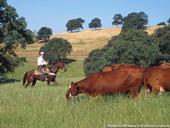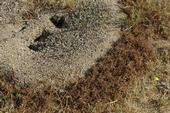- Author: Carl E. Bell
- Posted by: Gale Perez

Some tips on grazing for invasive plant control
Using livestock for controlling invasive plants has a lot of appeal; the animals seem like a natural, green method; they're cute; and at times they can be a very inexpensive way to do some weed control. But there are also various difficulties and issues with using livestock that should be understood before you jump into a grazing program, I've discussed some below.
Livestock have different eating preferences and needs; Cattle (photo of cattle courtesy of Jack Kelly Clark, UCANR) like grass, sheep like grass and forbs, goats like browse (foliage on stems of woody shrubs, young stems and bark, like photo), and horses like grass.
They eat...
- Author: Carl E. Bell
- Posted by: Gale Perez

While conducting a field experiment testing herbicides for control of sahara mustard in Borrego Springs in 2011, out of a corner of my eye I saw a ring of rusty brown around an ant hole.
Being curious I looked closer. It was an organized mound that was maybe 1 inch high and 3 inches across of redstem filaree (Erodium cicutarium) fruit. It was exclusively filaree, nothing else.
So I explored a little more on my knees and saw these small black ants a foot or so away on a well-beaten trail. Most of the ants had a filaree fruit in its mouth. I don't know the species of ant, but a quick Google search suggests that it is a species of...
- Posted by: Gale Perez
![Non-chemical weed control [photo credit: Weedtechnics]](https://ucanr.edu/blogs/UCDWeedScience/blogfiles/19320small.jpg)
Abstract: Reduction in herbicide use in non-agricultural areas is being imposed by a growing number of governments, triggering the development of alternative strategies for weed prevention and control. This study aimed to determine the weed preventive abilities of different paving types, the required treatment frequency of non-chemical weed control scenarios on these pavements and the associated weed species composition. A test parking area, constructed with four concrete paving types, was sown with a mixture of dominant weed species. Six scenarios with repeated use of a single weed control method (brushing with waste removal, hot air, selective application of hot water and three scenarios with flaming) and two...
- Author: Gale Perez
Join UC Farm Advisor Janet Caprile for an overview of weed management techniques for perennial and annual cropping systems that don't rely on synthetic herbicides or chemicals.
Wednesday, July 31, 2013
Livermore, California
For more information, click HERE.
- Re-posted by: Gale Perez
- Posted by: The Weed's Network
- Author: Steven Fennimore

Introduction
Weed seed are the means by which annual weeds reproduce and disperse. The seed buried in the soil is referred to as the seedbank. Most seed in the soil seedbank were produced in the same field or greenhouse. Some of the seed in the seedbank moved there through the actions of wind, water, animals or the activities of man. Annual weeds usually regenerate from seed stored in the soil seedbank. The seedbank reflects the effectiveness of recent weed management practices in the field or greenhouse and will determine future weed infestations. This article will outline some of the factors that influence weed seedbanks and how to use steam to kill weed seeds.
Weed...


